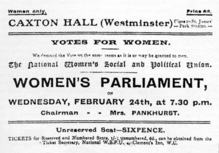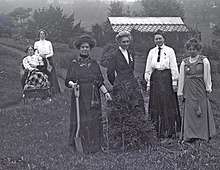Florence Haig
| Florence Eliza Haig | |
|---|---|
.jpg) Portrait of Haig, cropped from a group photograph | |
| Born | 1856 |
| Died | 1952 (aged 95–96) |
| Nationality | Scottish |
| Known for | Suffragette, artist |
Florence Eliza Haig (1856–1952) was a Scottish artist and suffragette who was decorated for imprisonments and hunger strikes.
Life
Haig's father was a Berwickshire barrister. She was an artist and her painting of the physicist John Tyndall was engraved and a copy is in the National Portrait gallery.[1]
Her involvement with the women's suffrage movement started with a £1 donation in 1901 to the National Union of Women's Suffrage Societies. She made another in 1907 but in February she was attracted to the rival Women's Social and Political Union. This was a more militant organisation led by the Emmeline Pankhurst. Haig she saw them in action at the "Women's Parliament" which was held on 24 February 1907 at Caxton Hall.[2]

Haig and her sister, Evelyn, started a local branch of the WSPU in Edinburgh, but she then left for London. A year after the Women's Parliament she was involved with the audacious "pantechnicon raid". This was where a furniture van (pantechnicon) was used as a "Trojan Horse"[1] to get twenty suffragettes to the House of Commons. When they were close, Haig, Maria Brackenbury, Georgina Brackenbury joined the rest who tried to rush their way into the lobby.[3] Haig was arrested together with the Brackenburys. They received six-week sentences.[2]

Haig's imprisonment was celebrated. She was entitled to the tradition of planting a commemorative tree at the "Suffragette's Rest". The "Suffragette's Rest" was the nickname for Mary Blathwayt's home of Eagle House in Somerset. This was where Blathwayt's parents indulged their WSPU enthusiasm. Her parents had set land aside to plant an individual tree for each WSPU member sentenced to prison. The planting was then photographed by Blathwayt's father. The trees and the photographs recorded their achievements.
In 1912 the WSPU organised a mass window breaking campaign in London's Oxford Street. Many were arrested and Haig received a four-month sentence for her involvement. Haig immediately went on hunger strike and was subsequently released after four days.[1]
Haig joined the Society of Women Artists in 1934.[1] She died in 1952.[2]
References
- 1 2 3 4 "Florence Eliza Haig – Person – National Portrait Gallery". npg.org.uk. Retrieved 8 January 2018.
- 1 2 3 Elizabeth Crawford (2 September 2003). The Women's Suffrage Movement: A Reference Guide 1866–1928. Routledge. p. 257. ISBN 1-135-43402-6.
- ↑ Elizabeth Crawford (2001). The Women's Suffrage Movement: A Reference Guide, 1866–1928. Psychology Press. pp. 739–. ISBN 978-0-415-23926-4.
External links
- Florence E. Haig Metropolitan Police charge sheet – 1 March 1912